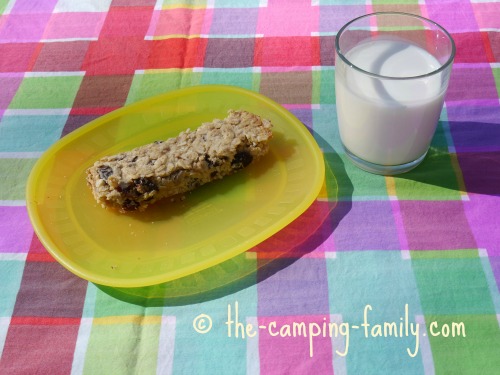Camping Tent Poles
Be sure to give some thought to the camping tent poles before you purchase a tent.
You might think that one tent pole is much like another. Not so! Choosing good tent poles is important.
A good set of poles with an easy-to-use installation system will make putting up your tent an easy and enjoyable experience.
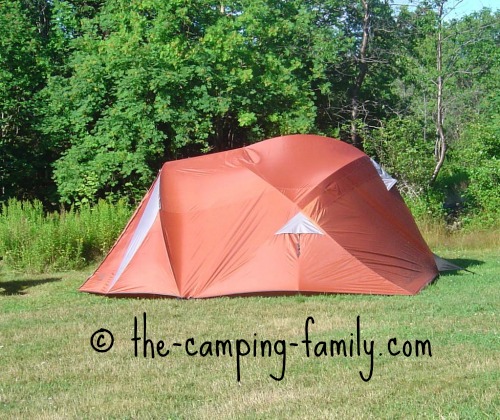
A poor set of poles, on the other hand, can make pitching your tent a nightmare.
Here's what you need to know to make an informed choice.
Portable Shower for Camping
This portable rechargeable camping shower set means you can shower anywhere!
Read more at Amazon here and find the best price!!
Types of Camping Tent Poles
Fiberglass
Some of the cheapest tents on the market have fiberglass poles.
Fiberglass camping tent poles are the least durable option. They break easily, leaving sharp shards of exposed fiberglass.
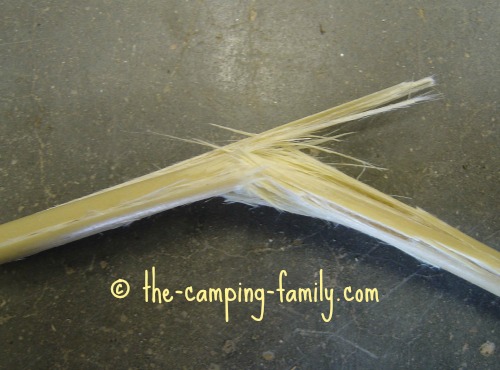
Don't touch this stuff!! The tiny glass particles can work their way under your skin, causing an itchy red rash.
My children once had a small play tent that had fiberglass poles. I can't count the number of times those poles snapped.
I would never buy a camping tent with fiberglass poles. I like to have my children help set up our camping tents. I don't want to worry that their enthusiastic efforts are going to break a pole.
By the way, it is possible to repair a fiberglass pole. You'll need sandpaper, fiberglass mat and resin - and lots of time, patience and skill. Fiberglass pole repair definitely isn't something you want to do in the middle of a camping trip!
Take my advice: don't buy a tent with fiberglass poles.
Aluminum
Most smaller, good quality tents have aluminum tent poles.
Aluminum camping tent poles are durable. They won't break under normal use.
If someone is roughhousing in the tent and falls heavily against a tent wall, an aluminum pole might bend - but you'll probably still be able to use it for the rest of the trip.
If it is too bent to be usable, you might be able to bend it back carefully into shape.
It's a good idea to pack a tent pole repair kit like this one. In the unlikely event that an aluminum pole does break, you'll be able to do a quick repair and continue to enjoy your trip.
Steel
Canvas tents and large, multiroom nylon tents are heavy. Many come with heavy steel poles that can support their weight.
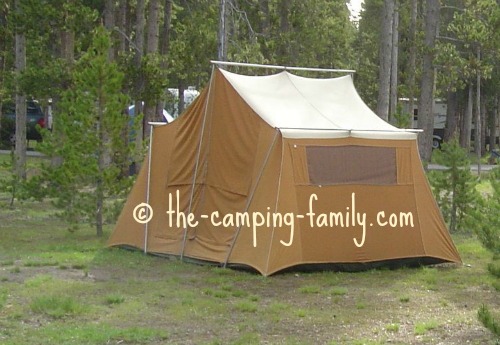
Steel camping tent poles are very durable.
Carbon
Carbon fiber camping tent poles are the strongest, lightest and most durable option. Of course, they are also the most expensive. They are found only on high-end backpacking tents. Unless you are planning to do extensive backpacking and need an ultralight system, you won't need anything this pricey.
Putting the poles together
Tent poles come apart for transport and storage.
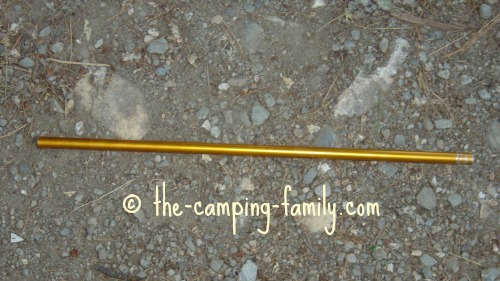
Before you can put your tent together, you'll first have to put the poles together.
The tricky part is making sure that you put the pieces in the correct positions!
Some pole systems are color coded to make this easier.
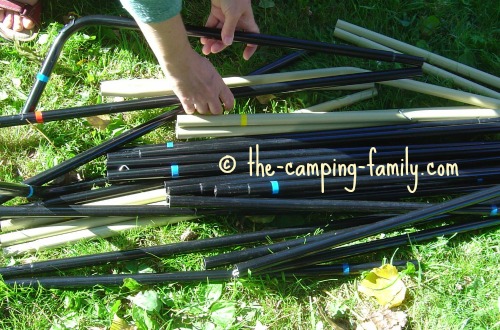 Color-coded poles
Color-coded polesJust match the colors, and you can't go wrong!
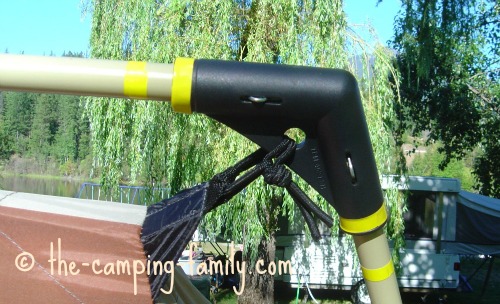
Others are linked together so you can't possibly put the wrong pieces together.
Here's a chain link system.
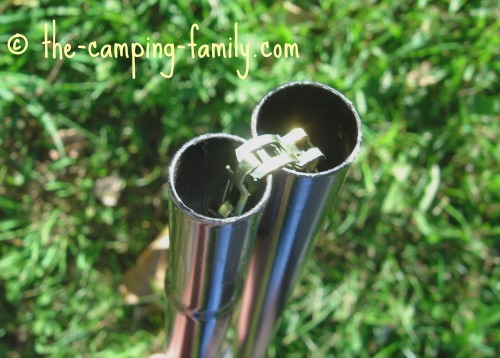
I like the elastic shock cord system. These poles are attached with a strong, stretchy cord.
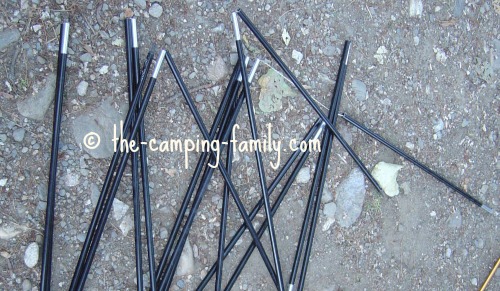
What if the cord breaks?
I've never, in 20+ years of tent ownership, had a shock cord break, but I've heard that it can happen.
Here are your options.
- Take the pole back to the store and ask them to repair it for you. You'll have a better chance of success with tent pole repair if you bought your tent from a reputable outdoor store.
- Buy a replacement shock cord. Again, a good outdoor store will stock these and will be able to tell you how to do the repair. I've heard that it's a fairly easy thing to do.
- Buy replacement tent poles. Be sure that you get the correct pole! Again, a respected manufacturer will be more likely to stock replacement parts. If you buy a cheap model from the discount store, you'll probably be out of luck when you try to buy a replacement pole that fits.
Attaching the Poles to the Tent
Once you've gotten the poles together, it's time to set them up and attach them to the tent. There are a number of different ways to do this.
Sleeves
Some tent systems require that you thread the pole through a long sleeve.
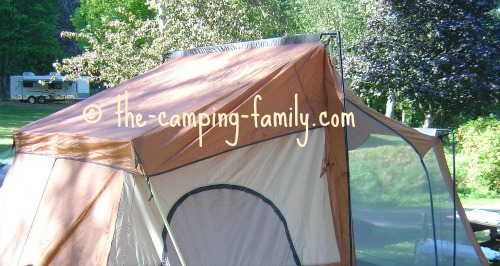
This can be a frustrating procedure - especially if there are many poles and many sleeves.
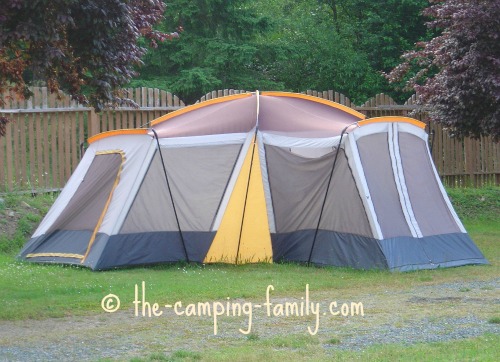
Unless you are extremely careful, the pole tends to get snagged on the sleeve.
Then, as often as not, the pole sections come apart! You have to pull the pieces out of the sleeve, put them back together, and start again.
Loops
I find that a system of loops is easier to use than a sleeve.
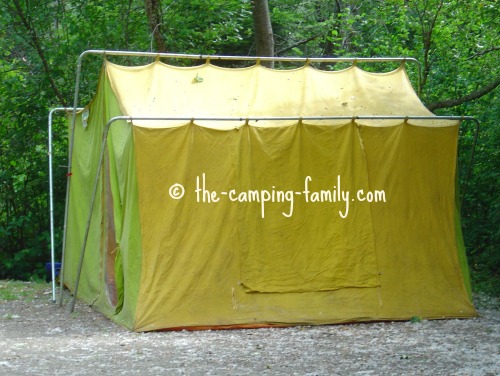
Since you thread the pole through a series of loops, there's no chance for the pole to get snagged.
Clips
This is my favorite system.
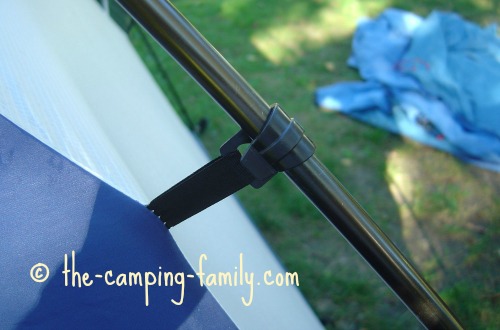
First you lay the tent on the ground.
Then you set up the poles.

Next, you clip the tent to the poles.
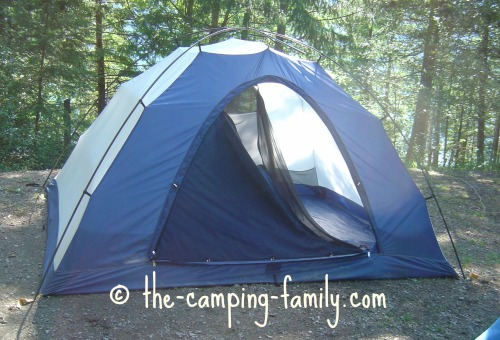
It's quick and easy!
Combination
Some tents use a combination of these systems.
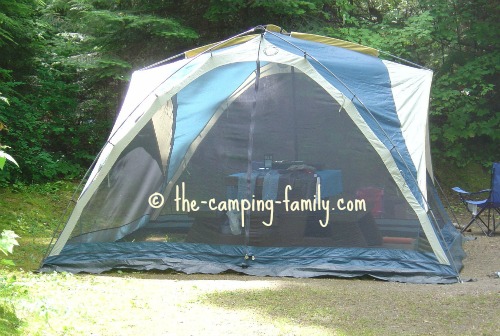
This tent has both sleeves and clips.
The Bottom Line
Look for a tent with these features:
- aluminum poles (unless your tent is huge and you need steel poles, or unless you are doing ultralight backpacking and can afford carbon fiber)
- an easy to understand system for putting together the poles (shock cords or color coding)
- an easy to use system for attaching the poles to the tent (I like the clip system.)
As with most things in life, you get what you pay for. A good quality tent with sturdy, easy-to-use poles will cost more than a tent with flimsy, frustrating poles.
By the way, be sure to put "tent poles" on your camping list! You don't want to arrive at your campsite with the tent - but no poles! (I'm speaking from experience here!)
Now that you know all about camping tent poles, click here to learn more about tents.
Once you've purchased your tent, you'll need to know how to set it up. Visit this page to learn all about pitching a tent.
For information on all aspects of your next camping adventure, visit The Camping Family home page.
Most Popular
Product of the Month
Iwatani Camp Stove
The perfect portable cooktop!
CLICK HERE for more information and best price
Recent Articles
-
Healthy Granola Bar Recipe: Easy Homemade Bars For A Camping Trip!
Apr 18, 25 10:48 AM
Use this easy healthy granola bar recipe to make delicious camping or hiking snacks. These homemade granola bars are perfect for a lunchbox or bedtime snack! -
Healthy Camping Recipes: Mandarin Black Bean Salad: Good Camping Food
Apr 18, 25 10:15 AM
Looking for healthy camping recipes? Mandarin Black Bean Salad is quick and easy to make, and uses non-perishable easy-to-pack ingredients. It tastes wonderful -
Hamburger And Rice Meal: Mexican Skillet Supper For Family Camping!
Apr 18, 25 10:04 AM
Delight your family with this easy hamburger and rice meal. It is perfect for camping - or to eat at home. It’s quick and easy, and everyone loves it!


